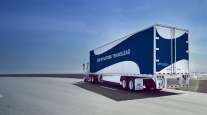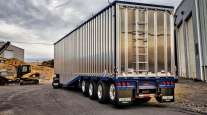Labor Challenges, Supply Chain Issues Continue to Hinder Trailer Production

[Stay on top of transportation news: Get TTNews in your inbox.]
Demand for trailers remains red-hot, but shortages of labor, components and supplies are restricting production, making it difficult for trailer makers to meet demand and set prices — with no end in sight for the long term.
Pent-up demand for trailers is estimated to be over 80,000 units because supply couldn’t keep up with demand last year. “Freight demand keeps growing, so fleets are in desperate need of new trailers,” said Don Ake, vice president of commercial vehicles at FTR. “Trailer builds should be at record levels in 2023, provided the supply chain can support it.”
Trailers are not immune to the woes that have plagued the supply chain since the onset of the pandemic. “Because of the health of the economy and freight, demand remains high, but the industry’s ability to meet customer expectations continues to be hampered,” said Steve Tam, vice president at ACT Research.

Due to a parts shortage, all trailer segments have been negatively impacted. Refrigerated vans have seen the most fluctuations. (Stoughton Trailers)
Ake added that more than 30 different components, from axles to decals, have been in short supply at some point over the last year.
Dave Kinsley, vice president of materials for East Manufacturing, said the Russia/Ukraine conflict has added a new layer of pressure on the price and availability of numerous raw materials, expanding the array of component shortages and the next wave of price increases and surcharges.
“Most discussions in 2021 revolved around semiconductors, steel, aluminum and copper,” he said. “These 2022 concerns have expanded to include nickel, magnesium, silicon, pig iron, carbon black and oil.”
Shortages continue to impact suppliers’ ability to ship components with computer chips, harnesses and power cables, Kinsley said. “While some have eased, new shortages arise often. Expect the unexpected,” he said, adding that castings have also become more difficult, and tire availability has become a bigger concern.
The main components in dry vans are steel, aluminum and wood, and there are shortages on all three of those fronts.
“A lot of times what will happen is we’re expecting a shipment of 200, and they can only send 180. A lot of our trailers are coming off incomplete because we’re missing components,” said David Giesen, vice president of sales for Stoughton Trailers. “We have to park them in the yard and pull them into a facility to add those components later.”
Tam noted that although the semiconductor shortage has dominated the headlines, the impact has not been as great on the trailer market as in other areas.
Richard Mansilla, vice president of global procurement for Wabash, said the trailer manufacturer is still experiencing inconsistencies in supplies, with chemical materials and chassis being some of the hardest items for the company to procure. However, Wabash has seen year-over-year improvements. “Overall, our supply base is catching up to us,” he said.
Finding Solutions
To minimize bottlenecks, Wabash deployed a strategy to deepen and strengthen its engagements and partnerships with suppliers. “We are now seeing the benefits of our commitment to that strategy as we believe our supply disruptions are less impactful than what some in our industry are experiencing,” Mansilla said.

With the Russia/Ukraine conflict, a new layer of pressure is added for manufacturers on the price and availability of numerous raw materials. (Stoughton Trailers)
In the same vein, Stoughton Trailers has ordered components further in advance than normal.
“Let’s say it had a two- to three-week lead time. Now we do a two- to four-month lead time,” Giesen said, adding that the manufacturer has added safety stock of components. “We’re doing that to try to keep things running, but when they aren’t available, you can’t get safety stock.”
Kinsley said East Manufacturing has worked to offset issues by adding some new suppliers and working with supply partners proactively to enhance the relationship and ensure supply consistency. “New strategies and frequent communication have been more effective than simply adding more suppliers,” he said.
At Peterson Manufacturing Co., the purchasing department is now placing orders for some commodities up to 12 months ahead, when the standard lead time had been six to eight weeks.
“Additionally, we have had to resort to purchasing some items on the spot market that have in the past been readily available from our regular suppliers,” said Al Anderson, vice president of sales and marketing for Peterson.
Anderson added that he sees the effect of near-shoring, and customers increasingly value the “Made In USA” message.
“Long lead times, sky-high shipping rates from Asia and extremely tight capacity is driving much of this sentiment,” he said. “Those companies that are in the position to capitalize on shorter lead times due to domestic production are definitely going to be preferred suppliers going forward.”
Manufacturers and fleets are also embracing substitutions, which Giesen said happen frequently. “We’ll call customers and say, ‘We were planning to give you X, but we’re going to give you Y to keep it moving,’ ” he said.
Tim Griesgraber, vice president of strategic accounts for Wabash, said the company has worked collaboratively with customers to provide alternative component options so it can deliver units.
Supply chain challenges and costs of materials are creating pricing challenges. Anderson said volatility in some raw material pricing is affecting Peterson’s ability to hold finished goods pricing for an extended period.
Stoughton has had to raise prices several times on some orders due to the long lead times and cost increases on raw materials. However, customers have been flexible.
“In the past, if you set a price, you held it, but you were four weeks out. Now they understand,” Giesen said.
Finding Workers
Labor shortages have factored into the production limitations over the past year and are a key reason suppliers have not been able to keep up with demand. Ake said some OEMs have given signing bonuses to factory workers.
“There has been some improvement recently, but this still could limit production going forward,” he said.

To minimize supply chain issues, some manufacturers are adding some new suppliers and working with supply partners to ensure consistency. (Wabash)
ACT Research’s Tam noted 2020’s COVID-induced labor challenges proved disruptive. As the number of new cases has declined, finding labor has become easier, but still challenging.
“Competition for labor is more intense today than it was before the pandemic, with so many workers having simply walked away from the workforce,” he said. “This appears to be a structural issue that manufacturers will be dealing with for some time to come.”
Giesen said he doesn’t expect labor issues to go away, which is driving automation.
“There is a new ROI. We’re looking at automation more than we have in the past and willing to make the investments,” he said. “Coming out of COVID ... we don’t have an abundant workforce wanting to go into these plants. We’ve been putting money at labor, trying to get people into the plants. That is helping but not enough.”
Peterson’s Anderson said that despite their best efforts, finding the type of worker they need has been extremely difficult.
“The set of skills needed to perform the tasks necessary to produce a very high-quality product is unique,” he said. “They must have high dexterity, be very detail-oriented and yet able to multitask is a special type of employee.”
Anderson noted that trailer OEMs understand the labor shortages have become a major strain and have worked with them to provide detailed information about which components are the most critical to their operations at a specific point in time.
“Giving us a longer lead time window into what their production schedules are helps us to plan work better and optimize production scheduling,” he said.
Pain Across the Board
Because there are so many components and parts in short supply, all trailer segments have been impacted. Refrigerated vans have seen the most fluctuations, since they contain the most parts, Ake explained.

Host Michael Freeze discusses the future of tire maintenance with Yokohama's Tom Clauer and Goodyear's Austin Crane and Jessica Julian. Hear a snippet above, and get the full program by going to RoadSigns.TTNews.com.
“Right now, dump trailer OEMs are experiencing issues, much of it connected to aluminum shortages,” he said.
ACT Research measures lead time by looking at the backlog of unbuilt units relative to the current rate of production. At the end of February, Tam stated, there were about 235,000 units in backlog, or about eight months’ worth of production. “So, if a fleet ordered a trailer today, they could reasonably expect delivery in eight months,” he added.
Tam noted that is an improvement over where the industry was a year ago, when delivery times stretched to almost a full year, owing both to very strong demand and supply chain-constrained production. Because the industry is still working its way through those constraints, it will be some time before lead times normalize, at four to six months.
At the end of 2021, Wabash’s backlog was up 70% over the prior-year quarter, Griesgraber said. “Our van trailers business is essentially fully booked for 2022,” he said. “Our other product lines are sporting higher-than-normal order backlogs, which continues to indicate constructive market demand conditions for 2022.”
As such, according to Giesen, Stoughton Trailers is fully booked for 2022 and 2023 is already forecasted to be full.
Chris Cooler, vice president of sales and marketing for East Manufacturing, said that while the company’s order boards have remained full, they are running behind. “We are working closely with the dealers and customers to keep them apprised of any delays,” he said. “Most customers, while not happy about it, understand and are keeping the orders they have.”
Want more news? Listen to today's daily briefing above or go here for more info
Fleets are working to squeeze out all the productivity they can from their existing trailer fleet. “There are probably fewer trailers sitting idle, but that is highly dependent on logistical factors for the individual fleet,” Ake said, adding that trailer dealers are refurbishing storage, drayage and other retired trailers to help meet fleets’ needs.
In addition, by extending trade cycles, fleets are holding onto equipment for longer than planned.
“If a fleet absolutely needs additional capacity and they are not able to purchase new, many have turned to the secondary market to supplement their trailer fleets,” Tam said. “Outsized demand and anemic supply have caused this solution to be more expensive than buying new in some cases.”




